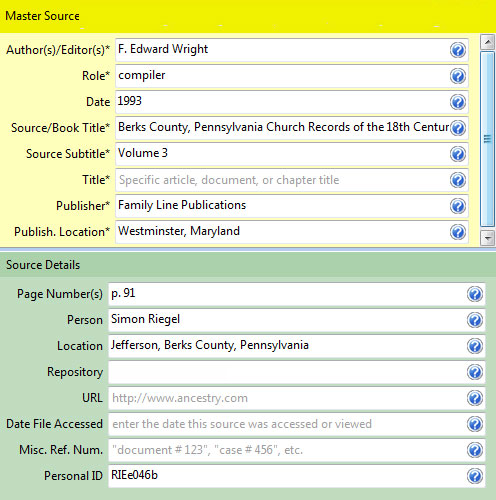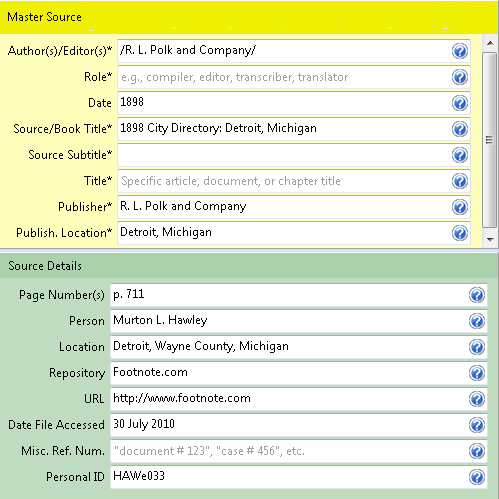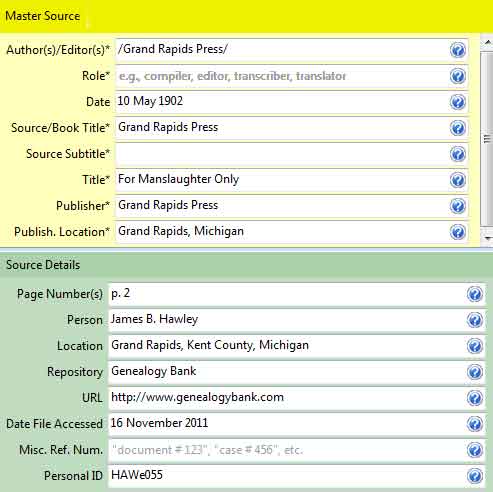Template Examples:Traditional
Traditional sources include books, magazines, journals, and other materials that are, more than likely, printed by a professional publisher and are, arguably, the easiest type of source to cite as they are most similar to other citation systems. This template contains a total of 17 elements, three of which are REQUIRED (these are highlighted in red). The following describes each field and examples of citations are provided below.
Master Source
- Author(s)/Editor(s): Provide the name of the individual(s) who created the source (in many cases, the name of an agency or other entity will be used). This field is REQUIRED.
- Role: Input the roles (e.g., compiler, editor, transcriber, editor, etc. of the individual[s]) who created this source. It is not necessary to indicate if the person's role was author as that is implied.
- Date: Enter the exact date (if known) that this source was created. Books only require the year of publication, articles often require the month, day, and year. As this is a REQUIRED field, if you don't know the exact date, then provide an estimate with a qualifier (e.g., about, between, circa).
- Source/Book Title: This field should contain the name of the book, magazine, etc. that represents the source.
- Source Subtitle: Indicate any subtitle of this source. If one is not present, then leave this field empty as it's optional.
- Title: This field is optional, however, the name of an article, chapter, or other title must be included here if one is available.
- Publisher: Most traditional sources have a publisher. If one is known, that information must be included here.
- Publisher Location: Similar to other citation systems, the city and state (or city and country) of the publisher should be listed. Note: Although abbreviations for state names may be used, I prefer to provide the entire name (that decision is left up to you - just be consistent).
Source Details
- Page Number(s): Most traditional sources have page numbers; list them here. (Syntax: p. [for a single page], pp. [for multiple consecutive pages].)
- Person: Provide the name of the specific person that this citation refers to.
- Location: Enter the city, county, state, and country where the event that is documented by this source occurred, otherwise leave this field empty. (If the event occurred in the U.S., I do not list the country as that is implied by the presence of a state name.)
- Repository: This is an optional field that is only used if the source is obtained over the Internet or is a one-of-a-kind document that is held in a private collection. If this document was obtained from a library, DO NOT list the repository. This is similar to the practice of traditional citation systems (e.g., those found in bibliographies) which never list repositories.
- URL: Although the full URL may be appropriate, listing only the home page of sites where a document is located (e.g., http://www.ancestry.com) is sufficient, as many of these, particularly those are from commercial sites that require subscriptions; listing the full URL from commercial sites will not be useful to those who don't subscribe. There is also a fairly new standard that genealogists haven't yet adapted - that is the use of a "Digital Object Identifier" - this is a number that is now attached to many electronic sources available on the Internet. In the unlikely event that a DOI is available, use that instead of the URL. Information on DOIs can be found here.
- Date File Accessed: This is another optional field that is only used to cite sources that are obtained on the Internet. In all other cases, it should be left blank.
- Misc. Ref. Num.: I have now used Simple Citations for more than ten years and have used this field on only a few occasions. Use this field sparingly.
- Personal ID: The information placed in this field refers to the personal numbering system you use to organize your family history. This information should never be printed on reports or in your citations. It is only used to help you keep track of your documentation.



